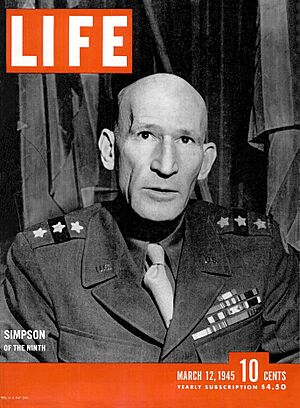Lieutenant general (United States) facts for kids
Quick facts for kids Lieutenant general |
|
|---|---|

Three-star insignia of the rank of lieutenant general. Style and method of wear may vary between different uniforms and different service branches.
|
|
   
Shoulder boards
|
|
| Country | |
| Service branch | |
| Abbreviation |
|
| Rank | Three-star |
| NATO rank | OF-8 |
| Non-NATO rank | O-9 |
| Next higher rank | General |
| Next lower rank | Major general |
| Equivalent ranks |
|
In the United States Armed Forces, a lieutenant general is a very high-ranking officer. They are known as a three-star general officer. This rank is used in the Army, Marine Corps, Air Force, and Space Force.
A lieutenant general ranks above a major general. They rank below a general. This rank is equal to a vice admiral in the Navy and Coast Guard. The pay grade for this rank is O-9.
Contents
What a Lieutenant General Does
A lieutenant general is a very important leader in the U.S. military. They command large groups of soldiers, Marines, or airmen. For example, an Army or Marine Corps lieutenant general often leads a "corps." A corps can have between 20,000 and 45,000 troops.
Air Force lieutenant generals command large air forces. They might also lead major commands. These officers also work in top offices at the The Pentagon. They often lead entire departments there.
How Many Lieutenant Generals Are There?
The United States government sets limits on how many generals can serve at one time. This includes lieutenant generals. For example, the Army has a limit of 231 generals. The Marine Corps has 62, and the Air Force has 198. Only about 25% of these can be three-star generals or higher. The President can change these limits during a war or national emergency.
Getting the Rank
Becoming a lieutenant general is a big deal. It is a temporary rank. Officers usually get this rank when they are chosen for a specific high-level job. Their rank lasts as long as they hold that job.
The President chooses officers for these roles. The Secretary of Defense and the Chairman of the Joint Chiefs of Staff give advice. The Senate must then approve the choice. Most lieutenant general jobs last for three years. Sometimes, they can be extended.
Retirement from Service
Lieutenant generals usually retire after 38 years of service. They must retire the month after their 64th birthday. However, the Secretary of Defense or the President can allow them to serve longer.
Officers often retire earlier than required. This helps younger officers get promoted. There are only a few three-star jobs available. When an officer leaves a three-star position, they usually retire. This makes space for someone new to be promoted.
History of the Rank
The rank of lieutenant general has a long history in the U.S. military.
Early History
The first officer to be a lieutenant general was George Washington. President John Adams gave him this rank during a time of tension with France. Over 60 years later, Ulysses S. Grant also became a lieutenant general. This was during the American Civil War.
In 1855, Winfield Scott was given the honorary rank of brevet lieutenant general. This was to honor his actions in the Mexican–American War. The rank was officially brought back in 1864. Later, in 1888, it was combined with the rank of General of the Army.
Famous Lieutenant Generals
Many important figures in U.S. history have held this rank.
Historic Leaders
- George Washington: The very first U.S. officer to hold this rank. He was later made a General of the Armies.
- Ulysses S. Grant: A key general in the Civil War. He later became a General of the Army.
- William T. Sherman: Another important Civil War general. He also became a General of the Army.
- Philip Sheridan: A famous cavalry leader from the Civil War. He too became a General of the Army.
- Thomas Holcomb: The first U.S. Marine to become a lieutenant general. He was the Commandant of the Marine Corps in 1942.
World War II Heroes
- Jimmy Doolittle: Led the famous Doolittle Raid on Japan.
- Leslie Groves: He was in charge of the top-secret Manhattan Project. This project developed the atomic bomb.
- George S. Patton: A well-known commander of the U.S. Third Army.
- Joseph Stilwell: A commander in the China Burma India Theater.
Modern Leaders
- Lewis B. "Chesty" Puller: The most decorated Marine in history. He received the Navy Cross five times.
- Thomas P. Stafford: A NASA astronaut who flew on several space missions.
- Carol A. Mutter: The first woman to become a lieutenant general in the Marine Corps (1996).
- Claudia J. Kennedy: The first woman to become a lieutenant general in the Army (1997).
- Susan Helms: A former Air Force commander and NASA astronaut.
- H. R. McMaster: Served as a National Security Advisor.
- Nina M. Armagno: The first Director of Staff for the U.S. Space Force.
See also
- List of active duty United States three-star officers
- United States Army officer rank insignia
- United States Marine Corps officer rank insignia
- United States Air Force officer rank insignia






